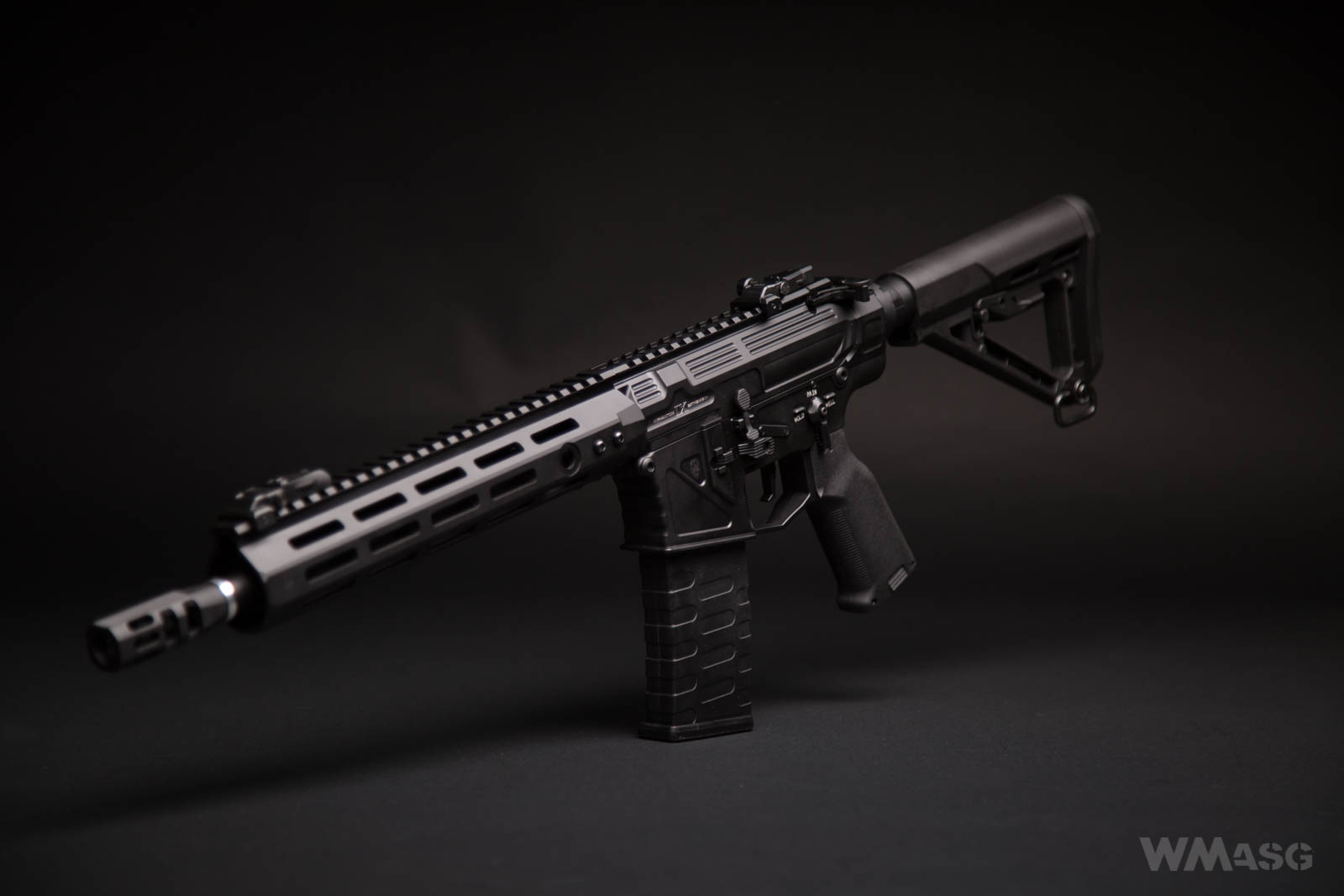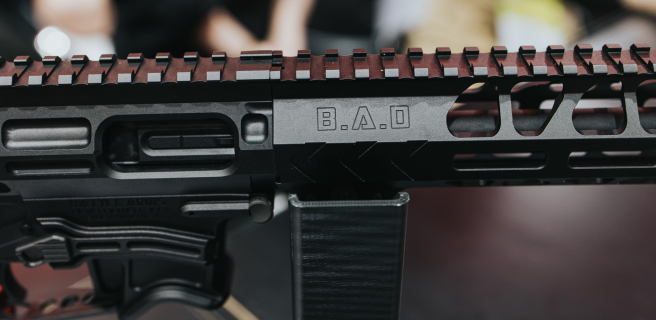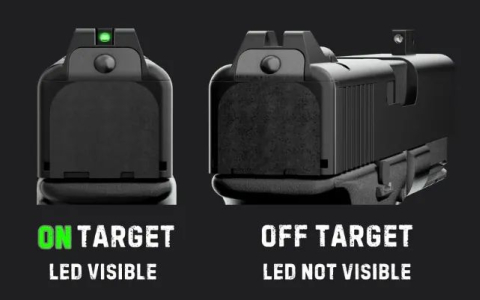
For a long time now, the APS company has been consistently promoting and developing a series of AR-15 replicas equipped with the Silver Edge gearbox. The Phantom Extremis line is no exception. The Taiwangun shots has just receiver the newest Phantoms, built using this platform. We are testing the Phantom Extremis Mk9 model. Its is a medium length carbine which has all the characteristic features of the, once again, modified Phantoms. This time they are equipped, among other things, with an electronic control system. Hence, a slightly different name of the replica, the eSilver Edge.

The set contains
- a hi-cap magazine made of plastic, with a capacity of 300 BBs;
- zero inspection sheet with the muzzle velocity measurement results and a paper target;
- a plastic cleaning rod;
- detachable folding sights (mounted on the replica);
- two short Picatinny rails mounted using the M-LOK system;
- a small hand stopper (mounted using the M-LOK system);
- one QD type swivel for attaching the carrying sling.
The sights, rails and hand stopper are made of plastic.

Basic technical parameters
- length: 730/815 mm (folded/unfolded stock);
- weight: 2500 g;
- length of the inner barrel: 297 mm;
- diameter of the inner barrel: 6.03 mm;
- magazine capacity: 300 BBs;
- muzzle velocity: 340-360 fps (manufacturer's data)

Appearance and external design
As far as the appearance goes, the Mk9 looks very good. It is uniformly black, light and fits perfectly in one's hands. In addition it is simply very carefully made and put together. Most external parts are identical to those found in the previous generations.
The aluminum alloy receiver is one of those modern designs with many aggressive looking ribs and reinforcing edges, without the ejector port dust cover. A slight cosmetic difference, compared to predecessors, are markings including firing mode selector settings. Here we have a slightly more climatic HOLD/PAIN/HELL designations.

Both parts of the receiver fit very tightly. The connection method used is the same as in the vast majority of replicas. The upper receiver slides onto the lower receiver and is secured in place with the front pin. An interesting fact to be noted - both main pins of the receiver have screws on both ends.

Apart from to the bolt catch, all other switches are double-sided and conveniently enlarged. In the photo above, the left button of the magazine release is very clearly visible. Below is the one mounted in the right side.
Worth mentioning are the differences in the length of the safety selector switches on each side of the receiver. This solution noticeably speeds up the change of the settings. By default the longer switch is mounted on the left side.

However, left-handed shooters can easily replace the switches without taking the replica apart. One just have to remember about the steel balls and and springs, which are located under each switch (and not just under the left one as is often the case).

The charging handle also has enlarged and double-sided latches.
The handle is functional, that is, pulling it back moves the dummy bolt carrier and gives access to the Hop-Up system adjustment. Here, I will point out two things. In APS replicas, the design of the dummy bolt carrier and charging handle is slightly different than in most other replicas. First of all, the handle itself has no spring and after locking the dummy bolt carrier in the rear position, the lever must be manually moved forward.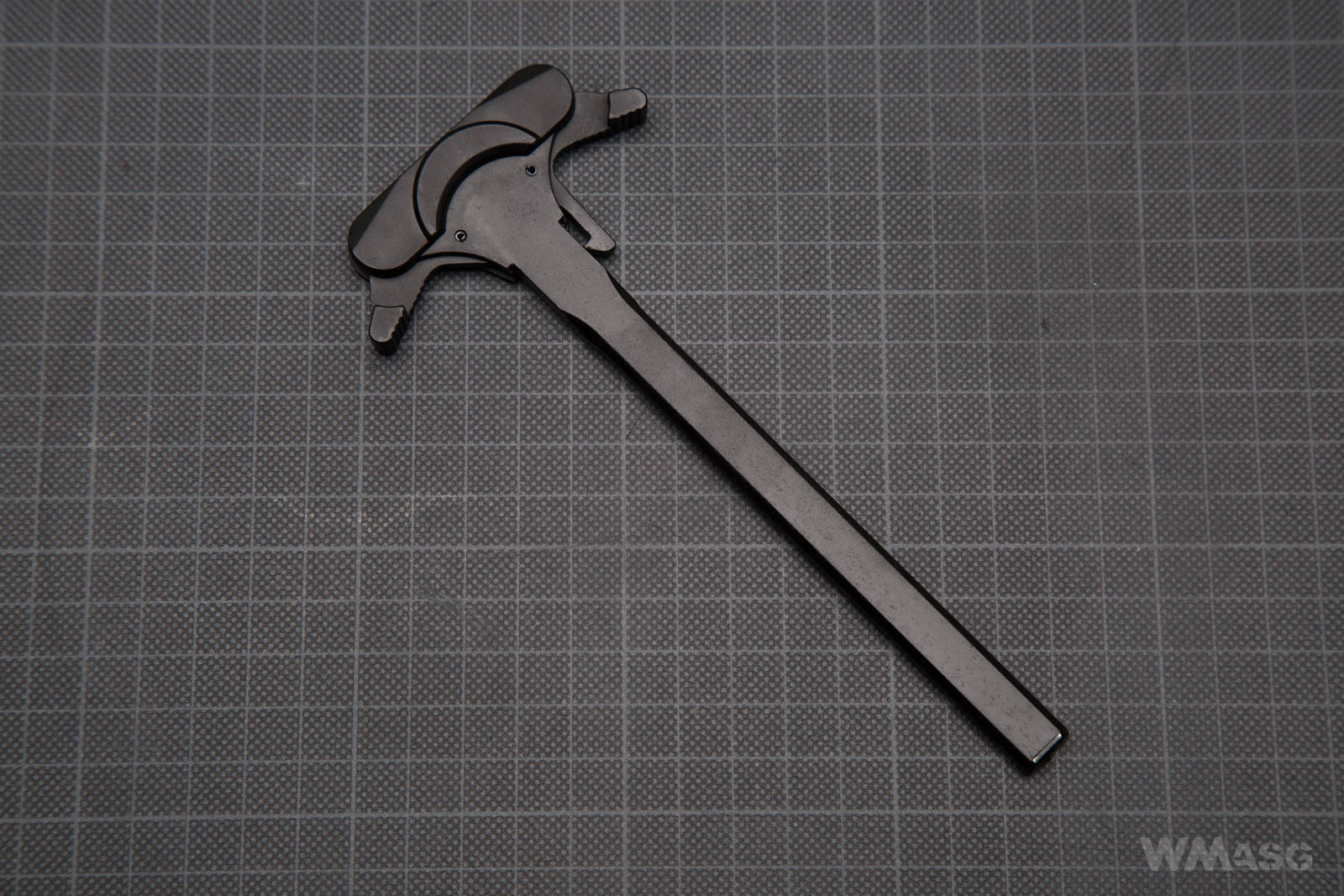
Secondly, the retracted dummy bolt carrier will not lock by itself. To do so, one has to press the lower part of the bolt catch (indicated by the red arrow).
This allows for a convenient Hop-Up adjustment. Pressing the upper part of the bolt catch will "drop" the dummy bolt carrier to the front position and if we have not moved the charging handle beforehand, it will pull it forward too.

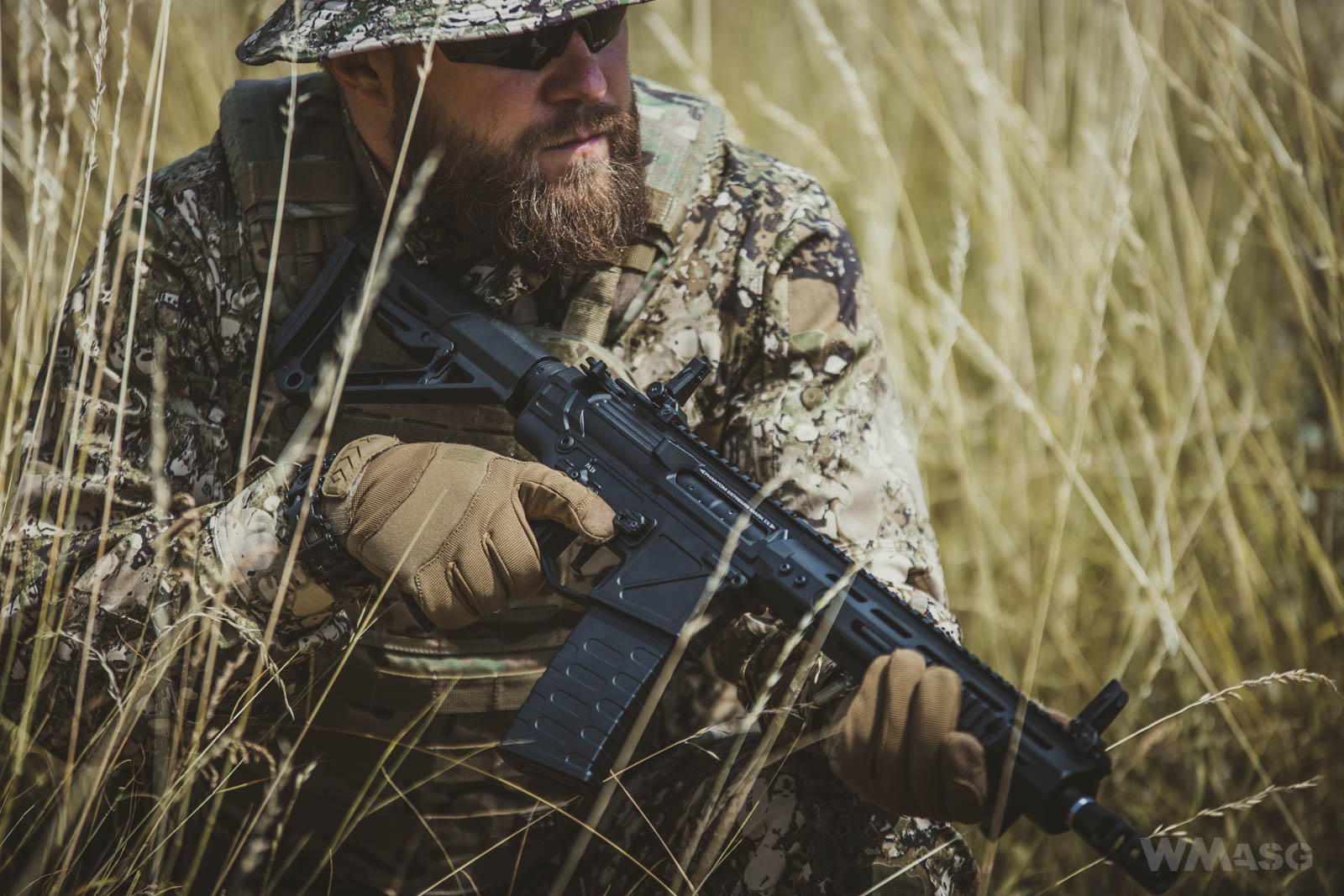
The front
The front of the replica is 10-inches long and is made of aluminum. Its is made in the M-LOK standard and has an octagonal cross-section.
 Its upper part is a standard Picatinny rail running along its entire length and ending where the top rail of the upper receiver begins. The connection is perfect, there is not even a smallest offset.
Its upper part is a standard Picatinny rail running along its entire length and ending where the top rail of the upper receiver begins. The connection is perfect, there is not even a smallest offset.

Both sides of the front have QD sockets for attaching the carrying sling mounting swivel.

The front is attached to the barrel mounting ring with six screws, two on the right side, two on the left and two at the bottom. In addition, the front goes over the upper receiver on both sides which, together with the six screws, provides a very stiff and secure connection.

The muzzle break
The barrel ends with a massive muzzle break mounted on a 14 mm counterclockwise thread.

In the bottom part there is a setting screw. After unscrewing it, you can unscrew the muzzle break and replace it with, for example, a silencer.
Removing it is also required to dismantle the front. By the way, as you can see, all APS replicas do not feature a dummy gas system.


The grip
The pistol grip is a DYTAC product bearing appropriate markings. It is made very carefully from hard plastic and fits perfectly with the lower receiver. It is inclined at a slightly different angle, which apparently has a positive effect on the precision and comfort of using the carbine.
 It features a tool-free access to the motor, at least in theory. It is done by pressing the latches on both sides of the grip which allow you can raise the flap, pull out the cover and remove the motor. In practice, pressing the latches with your fingers is difficult and painful.
It features a tool-free access to the motor, at least in theory. It is done by pressing the latches on both sides of the grip which allow you can raise the flap, pull out the cover and remove the motor. In practice, pressing the latches with your fingers is difficult and painful.
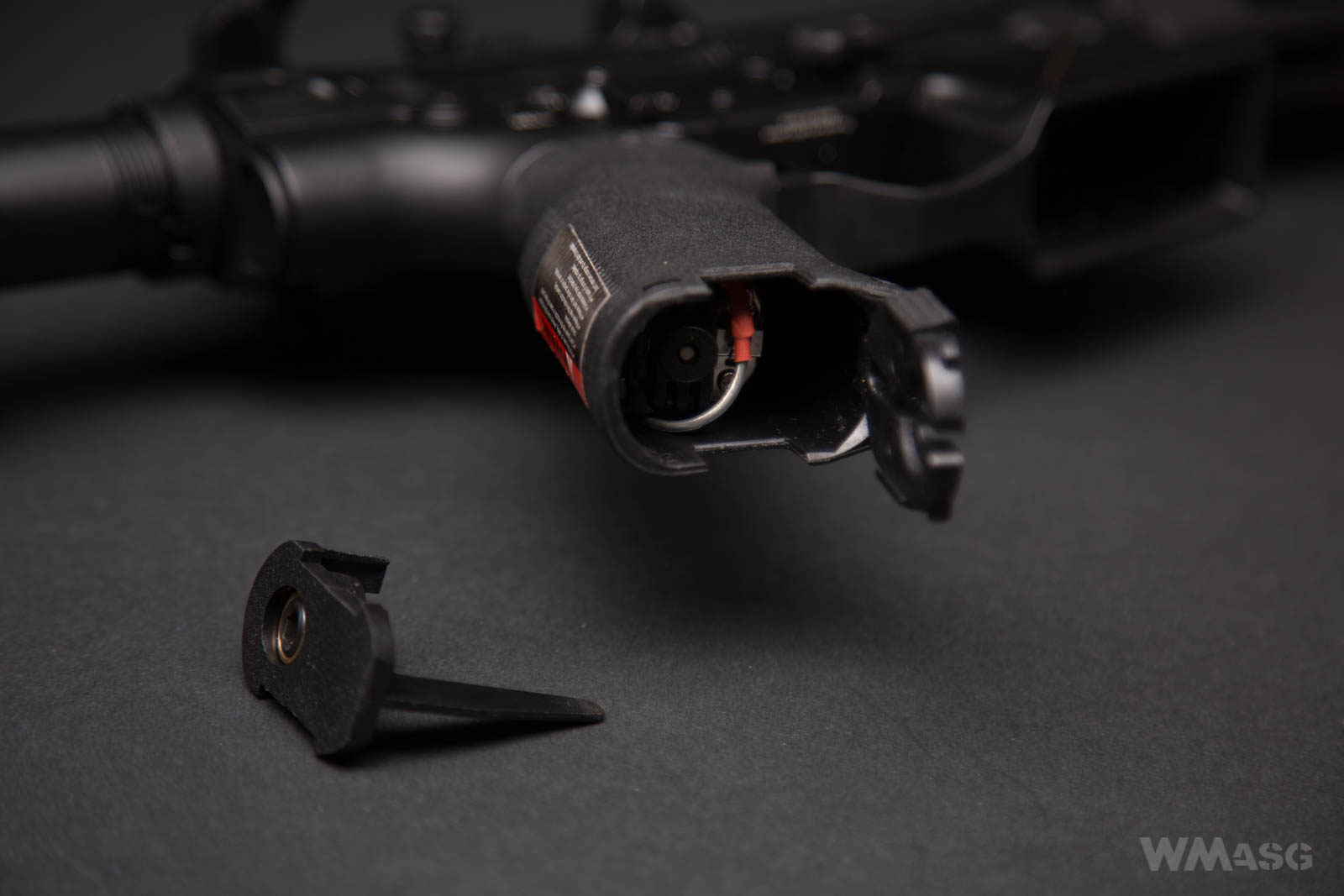
Luckily, the motor can be adjusted without opening the grip.

The sights
The Mk9 uses completely new folding Hawk sights.

 The set consists of a vertically adjustable front sight and a rear aperture sight with two settings, adjustable horizontal. Both sights are made of plastic. A small flat screwdriver is required for mounting them on the rail, but the adjustment is carried out without any tools.
The set consists of a vertically adjustable front sight and a rear aperture sight with two settings, adjustable horizontal. Both sights are made of plastic. A small flat screwdriver is required for mounting them on the rail, but the adjustment is carried out without any tools.



The buttstock
The six-position collapsible plastic stock has an integrated QD socket for the carrying sling mounting swivel. Access to the battery, for which there is a compartment in the guide, is gained after removing the already slightly protruding pin visible in the photo below
and opening the butt plate.

Unfortunately, as in all such designs, the space for the battery is very small. During testing, we used a 11.1V 1100 mAh battery.


The replica gives the ability to replace the spring relatively quickly. To do this, one has to disassemble the stock guide, which can be difficult without proper tools. We used a dedicated wrench. In the first picture, the crown nut only loosened.

Here the whole guide removed from the lower receiver.

View of the spring guide.

And both the spring and the guide removed.

To make matters clear, as they might not be so when looking at the photos above: of course, you do not have to separate the upper and lower receiver to replace the spring. There really is not even a need to pull the stock off the guide. The only thing you need to do is disconnect and remove the battery so that the wires have space and freedom of movement while unscrewing the stock guide.
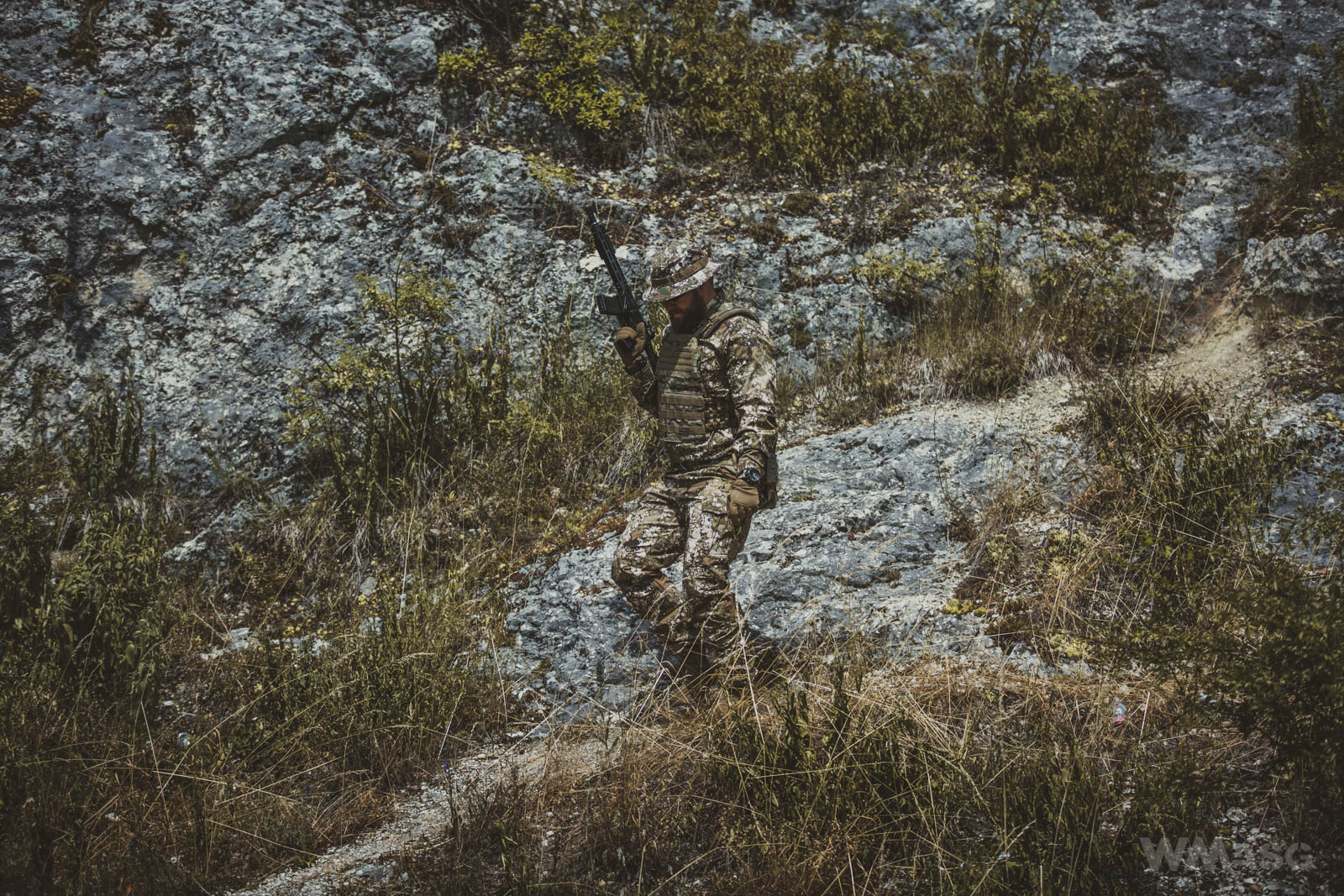
The magazine
The magazine that comes with the replica is a plastic hi-cap holding 300 BBs. It works on a classic principle and has a winding wheel at the bottom.
 APS calls these magazines U Mags. Stylistically, they resemble Magpul's products, but they are not copies of anything in particular. There are also straight shorter versions available, which hold 150 BBs.
APS calls these magazines U Mags. Stylistically, they resemble Magpul's products, but they are not copies of anything in particular. There are also straight shorter versions available, which hold 150 BBs.
The eSilver Edge gearbox
Earlier or more precisely, produced in parallel with the Silver Edge, the recently released eSilver Edge is not a new version the V2 gearbox, but rather the marketing name of a complete configuration, which consists of internal parts of the mechanism and the frame itself. Comparing both configuration types, it is clear that APS is constantly working on and improving its replicas. While the fact of using an electronic control system to drive the mechanism in the "e" version may seem debatable, the use of a piston with full steel teeth clearly indicates the direction in which APS is going.
 The main features of eSilver Edge are illustrated by the poster below:
The main features of eSilver Edge are illustrated by the poster below:
An animation, made by APS, presents all the individual parts and the operation of the mechanism:
The electronic system that the manufacturer calls SDU - Super Dynamic Unit continuously monitors the power consumption (which is always below 11 A according to APS), which will result in a slower discharge of a battery. In an event of a jam, the module will act as a fuse and cut off the power supply, which will protect against overheating and damage to the electronics or the motor. A micro-switch working together with the factory installed MOSFET slightly accelerates the reaction of the short-pull trigger.
The use of the SDU required considerable reaching modifications of the frame itself. Therefore, the only parts that are compatible with the unwritten Marui standard are the cylinder and its head, the spring, the piston, the tappet plate, the gears with the bearings and the anti-reversal latch. The frame, the trigger and selector plate are completely different. The cut-off lever is not used at all. What it more or less means is that when, for example, the gearbox frame is damaged you need to buy a dedicated (eSilver Edge) frame to replace the damaged part. Some handcrafted solutions made used standard Silver Edge gearbox (without electronics) or even with the standard V2 one might probably be possible, but there will certainly be problems with the correct work of the safety selector switch.
Another thing worth mentioning there is the fact that the Phantom Mk9 does not have an EBB (electric blowback) system, which we know from several other APS replicas. However, looking at complete mechanisms, it's hard not to notice some similarity. Below is the Mk9 mechanism again:

and here is the one used in the BDR-15, which we tested some time ago and which has an EBB system:

The difference lies, at first glance, only in the hooks present on dummy bolt cattier, those which are pulled by the moving piston and the rails leading the dummy bolt carrier. It is possible that if someone really wanted, he/she could convert the Phantom Mk9 to have an EBB. If electronics will allow that. The arrows on the photo above do not serve as any suggestions. The photo comes straight from the BDR-15 review and is slightly out of context.

Target shooting test and muzzle velocity test
The test was carried out on our own enclosed shooting range, at an ambient temperature of 28°C, the Hop-Up was set to zero.
The muzzle velocity measurements were made with the XCORTECH X3500 chronograph using Open Blaster 0.2 g BBs.
Test results:
1. 360.1
2. 369.8
3. 369.7
4. 366.4
5. 367.0
6. 364.4
7. 365.0
8. 365.6
9. 364.3
10. 36.7
Average: 365.6 fps.
Spread: 9.7 - not bad.
Kinetic energy at the barrel's end: 1.24 J
Measured rate of fire (using an 11.1 V 1100 mAh 20C LiPo battery) was 18.4 BBs/s.
Our measurements are a bit off compared with the information from the zero inspection sheet, but luckily, in an acceptable direction:
1. 343.0
2. 345.0
3. 339.0
4. 338.0
5. 341.0
6. 340.0
7. 339.0
8. 343.0
9. 340.0
10. 343.0
The target shooting test
The target shooting test was done using G&G 0.25 g BBs. Distance from the target was 25 m. The shooting was made using the K-Zone shooting rest.
10 shots were fired with a replica straight out of the box.
All shots hit the target.
Single fire shots:
The maximum spread between BB holes - 10 cm.
Full-auto shots: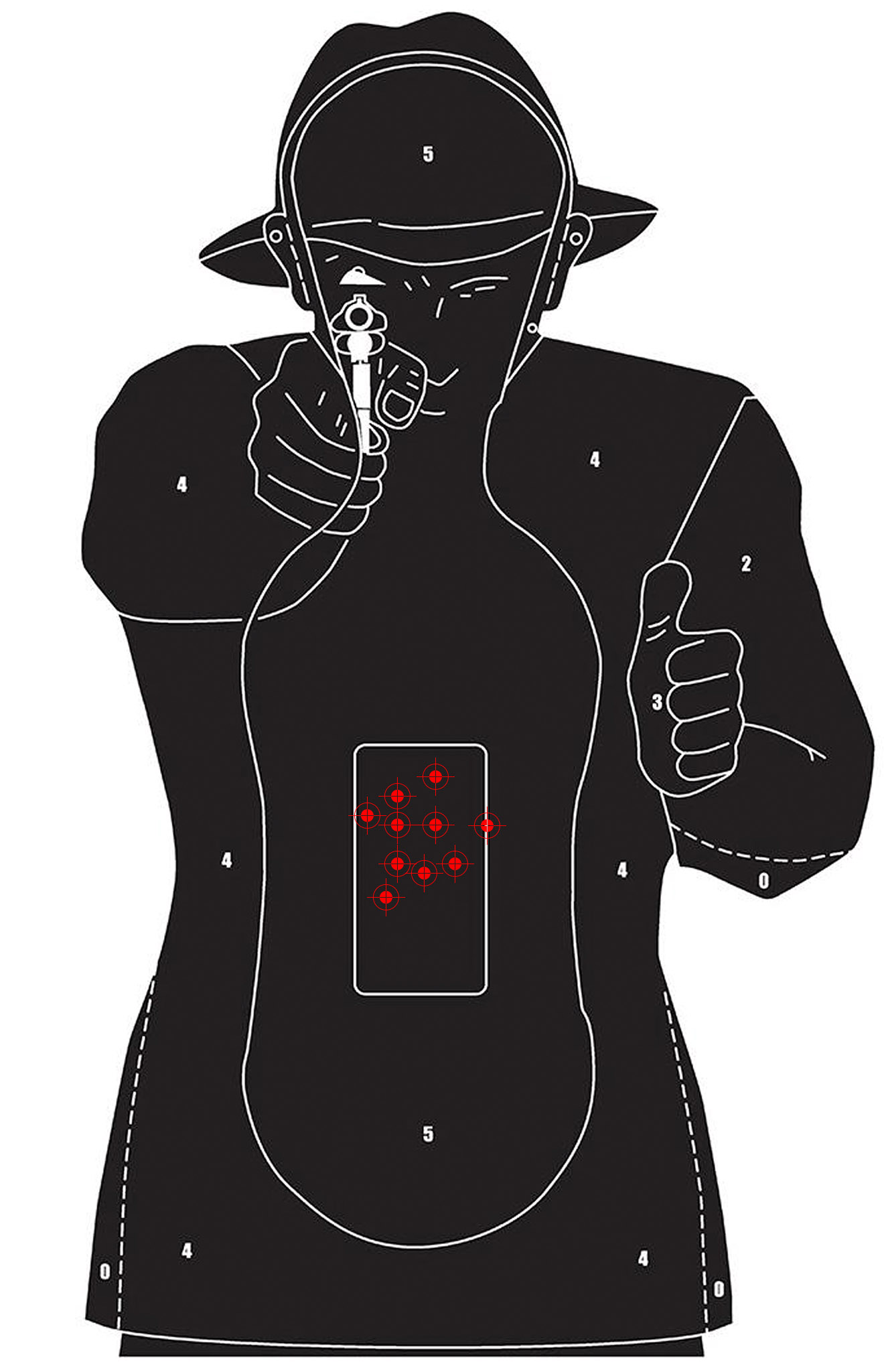
The maximum spread between BB holes - 6 cm.
Summary
Phantom Mk9 may find its fans. The modern and aggressive looking receiver of the carbine is really good. The quality of workmanship and assembly of the reviewed unit also leaves nothing to be desired. From the purely technical point of view, the use of control electronics may be debatable - some like it, others do not. But it is those electronics that are the main feature that distinguishes the eSilver Edge line. Therefore, the superiority of one solution over the other can be discussed somewhere on the side. The Phantom Mk9 has electronics. And they work. However, it is indisputable that there is a steady progress in the quality and durability of subsequent generations of Phantoms. The Mk9 has a new piston. What will the next generations show?

Supplement
Currently, 3 replicas from the eSilver Edge line are available at Taiwangun. They are designated as the Mk9, a longer one called the Mk8 and a shorter one called the Mk7.
The differences are primarily the length of the front and the flash hider used.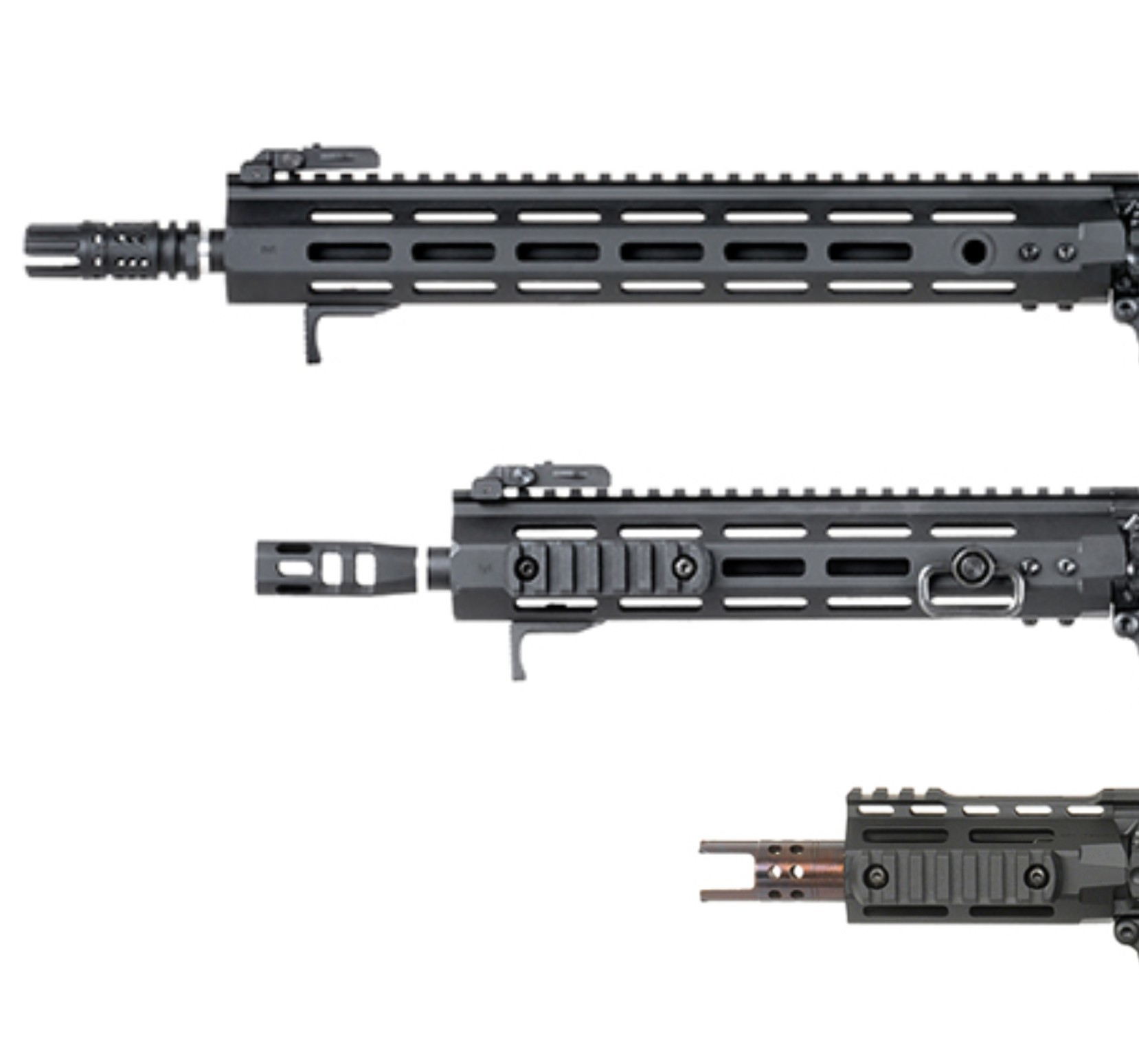
Mk7 also has an openwork magazine well and a different type of buttstock.
As we have learnt, it is possible that the Mk7 and Mk8 versions will also appear at other distributors. The Mk9 is a replica designed/configured in close cooperation between APS and Taiwangun, therefore it is only available at this store.

The next page contains technical details for those of you who are interested.

